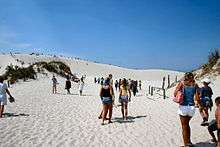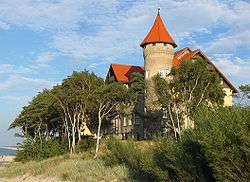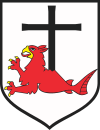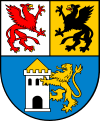Łeba
| Łeba | |||
|---|---|---|---|
|
Neptun hotel | |||
| |||
 Łeba | |||
| Coordinates: 54°47′N 17°33′E / 54.783°N 17.550°ECoordinates: 54°47′N 17°33′E / 54.783°N 17.550°E | |||
| Country |
| ||
| Voivodeship | Pomeranian | ||
| County | Lębork | ||
| Gmina | Łeba (urban gmina) | ||
| Area | |||
| • Total | 14.8 km2 (5.7 sq mi) | ||
| Population (2006) | |||
| • Total | 3,824 | ||
| • Density | 260/km2 (670/sq mi) | ||
| Postal code | 84–360 | ||
| Website |
www | ||

Łeba [ˈwɛba] (Kashubian/Pomeranian: Leba; German: Leba) is a town in the Pomeranian Voivodeship of Poland. It is located in the Gdańsk Pomeranian region (Pomorze Gdańskie), near Łebsko Lake and the mouth of the river Łeba on the coast of the Baltic Sea.
History
The Pomerelian settlement of Łeba was first mentioned in a 1282 deed. At that time the village was located about two kilometers (1.2 miles) west from the present mouth of the Łeba River. Łeba received municipal rights by the State of the Teutonic Order in 1357. Located at the Łebsko Lake at the Baltic Sea, it developed to a fishing port and a wood marketplace. With Lauenburg Land it became a Polish fief during the Thirteen Years' War in 1454, held by the Dukes of Pomerania.
Old Leba was threatened for many centuries by floods and expanding sand dunes and therefore was rebuilt in a safer location after 1558. The town fell back to the Polish Crown after the death of the last Pomeranian duke Bogislaw XIV until King John II Casimir Vasa enfeoffed Elector Frederick William I of Brandenburg-Prussia with Lauenburg Land by the 1657 Treaty of Bromberg.
With the First Partition of the Polish-Lithuanian Commonwealth in 1772, Leba was incorporated into Prussia. Soon after a large port was built on instruction of the Prussian king, whereby a 34-metre (112-foot) broad channel between the Leba lake and the Baltic Sea was dug, which however did not weather the storms on the coast. Due to its picturesque setting, the Leba seaside after World War I became a popular resort for German bohémiens. The painter Max Pechstein and other expressionists frequented the place.
In the proximity of Leba there is a large former testing area for long-range rocket weapons operated by the Rheinmetall company. On the Leba spit the German long-range rocket Rheinbote was tested between 1941 and 1945. Also the V-1 flying bomb was tested here from 1943 to 1945. Between 1963 and 1973 33 Polish sounding rockets of the type Meteor were launched in Łeba.[1]
In March 1945, shortly before the end of World War II, the region was occupied by the Red Army. According to the Potsdam Conference, after the end of the war the town was put together with Farther Pomerania under Polish administration. The local populace was evacuated by the Nazis or expelled and replaced by Poles.
Sights
There is an abundance of architectural and natural attractions near Łeba, above all the Słowiński National Park with its moving sand dunes, about 8 kilometres (5 miles) west of the city. Further objects of interest include:
- ruins of the Nikolaikirche (St. Nicholas church) west of the city on the way to the beach
- fishermen's church of 1683 with a painting by Max Pechstein
- fishermen's dwellings from the 19th century in Kosciuszki street
- the 19th century casino on Nadmorska street, today the Hotel Neptun
- former rocket test site near Pletka[2]
- the dinosaur park[3] south of the city
Demographics
Before World War II the (then German) inhabitants of the town were predominantly Protestants. Since the end of the war the population is predominantly composed of Roman Catholics.
| Year | Inhabitants | Notes |
|---|---|---|
| 1782 | 503 | no Jews.[4] |
| 1784 | 497[5] | |
| 1794 | 526 | no Jews.[4] |
| 1812 | 707 | incl. four Catholics and 16 Jews.[4] |
| 1816 | 639 | incl. two Catholics and 12 Jews.[4] |
| 1831 | 806 | incl. seven Catholics and two Jews.[4] |
| 1843 | 948 | incl. four Catholics and two Jews.[4] |
| 1852 | 1,093 | incl. seven Catholics and eight Jews.[4][6] |
| 1861 | 1,236 | incl. seven Catholics, eight Jews and one German Catholic.[4] |
| 1900 | 1,966[7] | |
| 1925 | 2,330[8] | |
| 1939 | 2,846[9] | |
| 1978 | 3,649[9] | |
See also
Famous people
- Claus Weiher aka Nicolaus, Claus zu Leba, father of
- Martin Weiher (1512–1556) Lutheran bishop of Cammin
International relations
Twin towns — Sister cities
Łeba is twinned with:
 Borgholm, Sweden
Borgholm, Sweden Zelenogradsk, Russia
Zelenogradsk, Russia Neringa, Lithuania
Neringa, Lithuania Hohnstorf, Germany
Hohnstorf, Germany Parma, Italy
Parma, Italy
References
- ↑ "Encyclopedia Astronautica".
- ↑ "Ostseebad Leba" (in German).
- ↑ "Łeba Park" (in Polish).
- 1 2 3 4 5 6 7 8 Kratz (1865), p. 254 (in German)
- ↑ Ludwig Wilhelm Brüggemann (Hrsg.): Ausführliche Beschreibung des gegenwärtigen Zustandes des Königlich-Preußischen Herzogtums Vor- und Hinterpommern. Part II, vol. 2, Stettin 1784, p. 1044 (in German).
- ↑ Topographisch-statistisches Handbuch des preußischen Staats (Kraatz, Hrsg.). Berlin 1856, p. 340 (in German).
- ↑ Meyers Großes Konversations-Lexikon. 6th edition, vol. 12, Bibliographisches Institut, Leipzig and Vienna 1908, p. 277 (in German).
- ↑ Der Große Brockhaus. 15th edition, vol. 11, Leipzig 1932, p. 203 (in German).
- 1 2 Johannes Hinz: Pommern. Wegweiser durch ein unvergessenes Land. Flechsig-Buchvertrieb, Würzburg 2002, ISBN 3-88189-439-X, p. 211 (in German).
External links
| Wikivoyage has a travel guide for Łeba. |
| Wikimedia Commons has media related to Łeba. |




